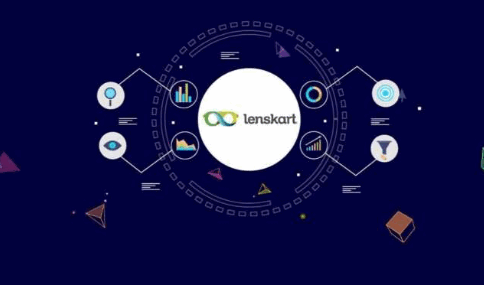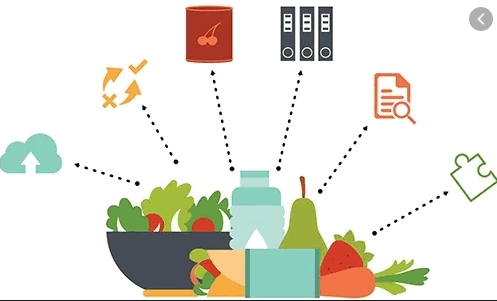ABSTRACT:
Every organization, whether big or small, has human resource challenges to overcome. Every organization has different faculty management needs; therefore, we design exclusive faculty management systems that are adapted to our managerial requirements. This is designed to assist in strategic planning and will help you ensure that in your organization is equipped with the right level of human resources for your future goals. Also, for those busy faculty members who are always on the go, our systems come with remote access features, which will allow you to manage your workforce anytime, at all times. Which means the allocation of time periods for particular staff is maintained by this application These systems will ultimately allow you to better manage resources. One of the main features in faculty management system is time tracking for faculty’s. Effective time tracking mechanism saves both time and money for the organization.
EXISTING SYSTEM:
• In the existing system, we are focusing on the major technical perceptions for our network visualization areas.
• Endpoint Connectivity (Host / Server Monitoring)
• Connectivity with the host and server will be monitoring for any downfall time
• Utilization of the system – details about the host vs server utilization.
• Number of accessible users - Calculating the individual and concurrent users on the system.
• Logging
• Packet Traces – tracing the packets traversing between the systems.
• Server logs – monitoring the security, application logs in the server.
• Port Activity
• server vs host interactions – monitor the port and protocol used in communication.
• level of activity through the port
• Intrusion detection
• Intrusion alerts – alerts create by the developers on anonymous activities.
• dns traces – recording anonymous entries in the domain.
DISADVANTAGES
• We couldn’t identify or specify the implication of the major disaster or network flaw in a system.
• They didn’t specify the exact pin point of issue and precautionary measures.
PROPOSED SYSTEM:
In the existing system, they’ve proposed various techniques in visualizing the network data. But unfortunately, they couldn’t identify or specify the implication of the major disaster or network flaw in a system. In our proposed approach , we provide the detailed visualize of the network information as mentioned below ,
• Number of TOTAL PACKET READS
• Latest packets read in a specific interval
• Number of TOTAL WRITES ON THE PACKETS
• Latest packets write in a specific interval
• Complete Input/output busy time
• Complete CPU busy schedule
• Complete Input/output Reads
• Latest number of seconds Input / Output reads
• Number of process info reported errors
• Number of spid’s reported error in the server
• Authentication information's
• Disabled services in the server
In our system, we are trying to project the detailed view of how the problem occurred and possible solution for the servers. Intrusion related information's were considered and precautionary measures towards intrusions will be addressed in our future work.
ADVANTAGES
• Security events from the server and the interaction with the client were visualized
• Visualized all the system process of server and also User contexts information were visualized
• Traces of the data navigation happening in the network seeing data’s in visualization manner
ARCHITECTURE:
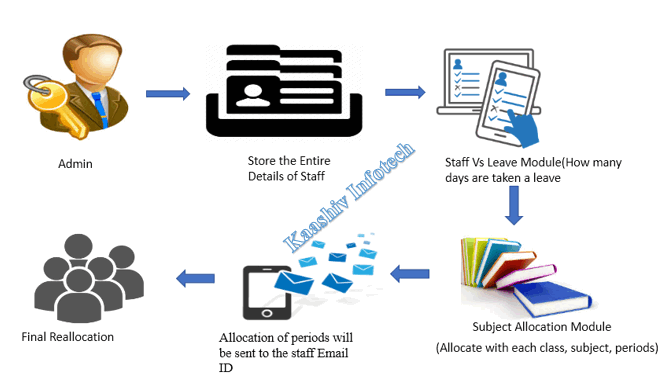
SCREENSHOT:
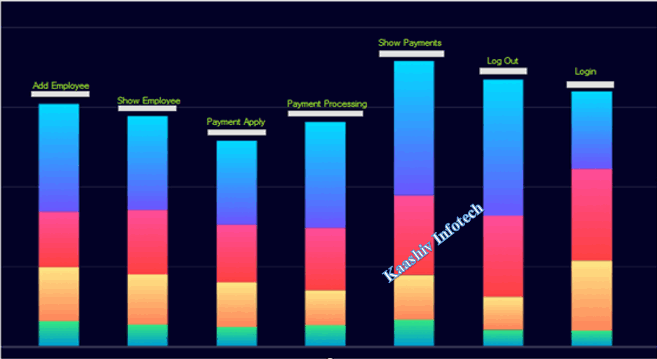
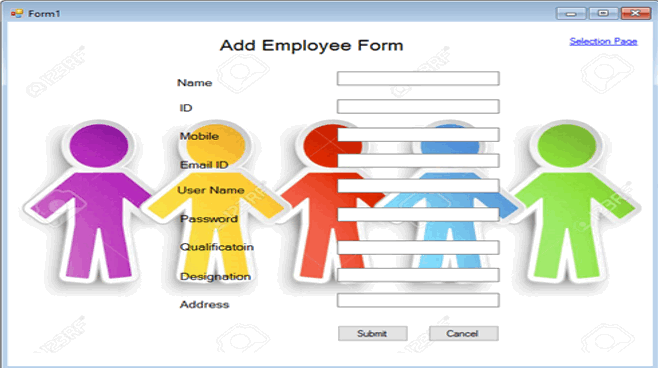
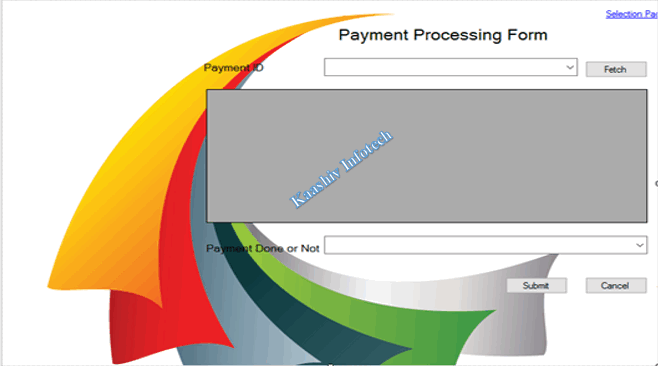
SAMPLE CODE:
Welcome .cs
using System;
using System.Collections.Generic;
using System.ComponentModel;
using System.Data;
using System.Drawing;
using System.Linq;
using System.Text;
using System.Windows.Forms;
namespace faculty
{
public partial class Form1 : Form
{
public Form1()
{
InitializeComponent();
}
private void label2_Click(object sender, EventArgs e)
{
Login log = new Login();
log.Show();
this.Hide();
}
private void Form1_Load(object sender, EventArgs e)
{
}
private void label1_Click(object sender, EventArgs e)
{
}
private void linkLabel1_LinkClicked(object sender, LinkLabelLinkClickedEventArgs e)
{
Login log = new Login();
log.Show();
this.Hide();
}
private void button1_Click(object sender, EventArgs e)
{
this.Close();
}
private void linkLabel2_LinkClicked(object sender, LinkLabelLinkClickedEventArgs e)
{
Signup UP = new Signup();
UP.Show();
this.Hide();
}
private void button2_Click(object sender, EventArgs e)
{
Attendance UP = new Attendance();
UP.Show();
this.Hide();
}
}
}
Login.cs
using System;
using System.Collections.Generic;
using System.ComponentModel;
using System.Data;
using System.Drawing;
using System.Linq;
using System.Text;
using System.Windows.Forms;
using System.Data.SqlClient;
namespace faculty
{
public partial class Login : Form
{
public Login()
{
InitializeComponent();
}
private void button1_Click(object sender, EventArgs e)
{
SqlConnection con = new SqlConnection(@"Data Source=KIT2-PC\VENKAT;Integrated Security=true;Initial Catalog=dms;");
SqlCommand cmd = new SqlCommand(@"select Count(*) as cnt from signup where username=@usr and password=@pwd", con);
cmd.Parameters.Clear();
cmd.Parameters.AddWithValue("@usr", textBox1.Text);
cmd.Parameters.AddWithValue("@pwd", textBox2.Text);
con.Open();
if (textBox1.Text == "" && textBox2.Text == "")
{
MessageBox.Show("Fill the form properly");
}
else
{
if (cmd.ExecuteScalar().ToString() == "1")
{
MessageBox.Show("Successfully logged in");
Form3 cat = new Form3();
cat.Show();
this.Hide();
}
else
{
MessageBox.Show("Invalid login");
}
}
}
private void textBox1_TextChanged(object sender, EventArgs e)
{
}
private void button2_Click(object sender, EventArgs e)
{
this.Close();
}
private void button3_Click(object sender, EventArgs e)
{
this.Close();
}
private void Login_Load(object sender, EventArgs e)
{
}
}
}
Signup.cs
using System;
using System.Collections.Generic;
using System.ComponentModel;
using System.Data;
using System.Drawing;
using System.Linq;
using System.Text;
using System.Windows.Forms;
using System.Data.SqlClient;
namespace faculty
{
public partial class Signup : Form
{
public Signup()
{
InitializeComponent();
}
private void button2_Click(object sender, EventArgs e)
{
this.Close();
}
private void linkLabel1_LinkClicked(object sender, LinkLabelLinkClickedEventArgs e)
{
Form1 f1 = new Form1();
f1.Show();
this.Hide();
}
private void button1_Click(object sender, EventArgs e)
{
if (textBox1.Text == "" || textBox2.Text == "" || textBox3.Text == "" || textBox4.Text == "" || textBox5.Text == "" || textBox6.Text == "")
{
MessageBox.Show("Please fill all the details");
}
else
{
SqlConnection connec = new SqlConnection(@"Data Source =KIT2-PC\VENKAT; Integrated Security =true;Initial Catalog = Faculty_Remuneration");
connec.Open();
SqlCommand cmnd = new SqlCommand(@"insert into signup(fn,ln,mbno,un,pwd,cnpwd) values('" + textBox1.Text + "','" + textBox2.Text + "','" + textBox3.Text + "','" + textBox4.Text + "','" + textBox5.Text + "','" + textBox6.Text + "')", connec);
if (textBox5.Text == textBox6.Text)
{
int x = cmnd.ExecuteNonQuery();
if (x > 0)
{
MessageBox.Show("Data entered sucessfully");
Signup day = new Signup();
day.Show();
this.Hide();
}
}
else
{
MessageBox.Show("please check the pwd");
}
connec.Close();
}
}
private void button3_Click(object sender, EventArgs e)
{
this.Close();
}
private void Signup_Load(object sender, EventArgs e)
{
}
}
}
Faculty.cs
using System;
using System.Collections.Generic;
using System.ComponentModel;
using System.Data;
using System.Drawing;
using System.Linq;
using System.Text;
using System.Windows.Forms;
namespace faculty
{
public partial class Form3 : Form
{
public Form3()
{
InitializeComponent();
}
private void label1_Click(object sender, EventArgs e)
{
AFTERLOGIN AFT = new AFTERLOGIN();
AFT.Show();
this.Hide();
}
private void label2_Click(object sender, EventArgs e)
{
Form2 fr = new Form2();
fr.Show();
this.Hide();
}
private void Form3_Load(object sender, EventArgs e)
{
}
private void label2_Click_1(object sender, EventArgs e)
{
Form4 frm = new Form4();
frm.Show();
this.Hide();
}
private void button1_Click(object sender, EventArgs e)
{
this.Close();
}
}
}
Home.cs
using System;
using System.Collections.Generic;
using System.ComponentModel;
using System.Data;
using System.Drawing;
using System.Linq;
using System.Text;
using System.Windows.Forms;
using System.Data.SqlClient;
namespace faculty
{
public partial class AFTERLOGIN : Form
{
public AFTERLOGIN()
{
InitializeComponent();
}
private void button1_Click(object sender, EventArgs e)
{
if (textBox1.Text == "" || textBox3.Text == "" || textBox4.Text == "" || textBox5.Text == "" || textBox6.Text == "")
{
MessageBox.Show("Please fill all tghe details");
}
else
{
string faculty_name = textBox1.Text;
string dept = textBox3.Text;
int dept_id = Convert.ToInt32(textBox4.Text);
int classes = Convert.ToInt32(textBox5.Text);
int perclass = Convert.ToInt32(textBox6.Text);
int salary = Convert.ToInt32(textBox7.Text);
SqlConnection connc = new SqlConnection(@"Data Source =KIT2-PC\VENKAT; Integrated Security =true;Initial Catalog = Faculty_Remuneration");
connc.Open();
SqlCommand cmd = new SqlCommand(@"insert into faculty3(faculty_name,dept,dept_id,classes,amountperclass,salary) values('" + textBox1.Text + "','" + textBox3.Text + "','" + textBox4.Text + "','" + textBox5.Text + "','" + textBox6.Text + "','" + textBox7.Text + "')", connc);
int x = cmd.ExecuteNonQuery();
if (x > 0)
{
MessageBox.Show("Data entered sucessfully");
Form3 day = new Form3();
day.Show();
this.Hide();
}
else
{
MessageBox.Show("Data not entered sucessfully");
}
connc.Close();
}
}
private void button2_Click(object sender, EventArgs e)
{
Form3 log = new Form3();
log.Show();
this.Hide();
}
private void textBox6_CursorChanged(object sender, EventArgs e)
{
}
private void label2_Click(object sender, EventArgs e)
{
}
private void AFTERLOGIN_Load(object sender, EventArgs e)
{
}
private void textBox7_ParentChanged(object sender, EventArgs e)
{
}
private void textBox7_TextChanged(object sender, EventArgs e)
{
}
private void AFTERLOGIN_BackColorChanged(object sender, EventArgs e)
{
}
private void textBox6_TextChanged(object sender, EventArgs e)
{
int a, b;
a = Convert.ToInt32(textBox5.Text);
b = Convert.ToInt32(textBox6.Text);
if (a != 0 && b != 0)
{
textBox7.Text = Convert.ToString(a * b);
}
else
{
textBox7.Text = "0";
}
}
private void button2_Click_1(object sender, EventArgs e)
{
Form3 f3 = new Form3();
f3.Show();
this.Hide();
}
}
}
Name.cs
using System;
using System.Collections.Generic;
using System.ComponentModel;
using System.Data;
using System.Drawing;
using System.Linq;
using System.Text;
using System.Windows.Forms;
using System.Data.SqlClient;
namespace faculty
{
public partial class Form2 : Form
{
public Form2()
{
InitializeComponent();
}
private void button1_Click(object sender, EventArgs e)
{
SqlConnection connc = new SqlConnection(@"Data Source =KIT2-PC\VENKAT; Integrated Security =true;Initial Catalog = Faculty_Remuneration");
connc.Open();
//SqlCommand cmd1 = new SqlCommand("SELECT faculty_name FROM faculty3", connc);
//SqlDataReader reader = cmd1.ExecuteReader();
//AutoCompleteStringCollection MyCollection = new AutoCompleteStringCollection();
//while (reader.Read())
//{
// MyCollection.Add(reader.GetString(0));
//}
//textBox1.AutoCompleteCustomSource = MyCollection;
String val = textBox1.Text;
SqlCommand cmd = new SqlCommand(@"select * from faculty3 where dept_ID='" + val + "'", connc);
SqlDataAdapter dta = new SqlDataAdapter(cmd);
DataSet dts = new DataSet();
dta.Fill(dts);
dataGridView1.DataSource = dts.Tables[0];
connc.Close();
}
private void dataGridView1_CellContentClick(object sender, DataGridViewCellEventArgs e)
{
}
private void dataGridView1_CellContentClick_1(object sender, DataGridViewCellEventArgs e)
{
}
private void Form2_Load(object sender, EventArgs e)
{
}
private void linkLabel1_LinkClicked(object sender, LinkLabelLinkClickedEventArgs e)
{
Form3 fa3 = new Form3();
fa3.Show();
this.Hide();
}
private void button2_Click(object sender, EventArgs e)
{
SqlConnection connc1 = new SqlConnection(@"Data Source =KIT2-PC\VENKAT; Integrated Security =true;Initial Catalog = Faculty_Remuneration");
connc1.Open();
SqlCommand cmd1 = new SqlCommand(@"delete from faculty3 where faculty_ID='" + textBox1.Text + "'", connc1);
MessageBox.Show("Data deleted successfully");
SqlDataAdapter dta1 = new SqlDataAdapter(cmd1);
DataSet dts1 = new DataSet();
dta1.Fill(dts1);
//dataGridView1.DataSource = dts1.Tables[0];
connc1.Close();
}
private void button3_Click(object sender, EventArgs e)
{
SqlConnection connc1 = new SqlConnection(@"Data Source =KIT2-PC\VENKAT; Integrated Security =true;Initial Catalog = Faculty_Remuneration");
connc1.Open();
SqlCommand cmd1 = new SqlCommand(@"select * from faculty3 ", connc1);
SqlDataAdapter dta1 = new SqlDataAdapter(cmd1);
DataSet dts1 = new DataSet();
dta1.Fill(dts1);
dataGridView1.DataSource = dts1.Tables[0];
connc1.Close();
}
private void button4_Click(object sender, EventArgs e)
{
this.Close();
}
}
}
Department.cs
using System;
using System.Collections.Generic;
using System.ComponentModel;
using System.Data;
using System.Drawing;
using System.Linq;
using System.Text;
using System.Windows.Forms;
using System.Data.SqlClient;
namespace faculty
{
public partial class Form4 : Form
{
public Form4()
{
InitializeComponent();
}
private void dataGridView1_CellContentClick(object sender, DataGridViewCellEventArgs e)
{
}
private void linkLabel1_LinkClicked(object sender, LinkLabelLinkClickedEventArgs e)
{
Form3 frm3 = new Form3();
frm3.Show();
this.Hide();
}
private void button1_Click(object sender, EventArgs e)
{
SqlConnection connec = new SqlConnection(@"Data Source =KIT2-PC\VENKAT; Integrated Security =true;Initial Catalog = Faculty_Remuneration");
connec.Open();
//SqlCommand cmd1 = new SqlCommand("SELECT faculty_name FROM faculty3", connc);
//SqlDataReader reader = cmd1.ExecuteReader();
//AutoCompleteStringCollection MyCollection = new AutoCompleteStringCollection();
//while (reader.Read())
//{
// MyCollection.Add(reader.GetString(0));
//}
//textBox1.AutoCompleteCustomSource = MyCollection;
string filterval1 = textBox1.Text;
SqlCommand cmd = new SqlCommand(@"select * from faculty3 where dept='" + textBox1.Text + "'", connec);
SqlDataAdapter dta = new SqlDataAdapter(cmd);
DataSet dts = new DataSet();
dta.Fill(dts);
dataGridView1.DataSource = dts.Tables[0];
connec.Close();
}
private void button2_Click(object sender, EventArgs e)
{
this.Close();
}
private void Form4_Load(object sender, EventArgs e)
{
}
}
}
Attendance .cs
using System;
using System.Collections.Generic;
using System.ComponentModel;
using System.Data;
using System.Drawing;
using System.Linq;
using System.Text;
using System.Windows.Forms;
using System.Data.SqlClient;
namespace faculty
{
public partial class Attendance : Form
{
public Attendance()
{
InitializeComponent();
}
private void button1_Click(object sender, EventArgs e)
{
SqlConnection connc = new SqlConnection(@"Data Source =KIT2-PC\VENKAT; Integrated Security =true;Initial Catalog = Faculty_Remuneration");
connc.Open();
SqlCommand cmd = new SqlCommand(@"update faculty3 set faculty_name='"+textBox1.Text+"',date='"+dateTimePicker1.Text+"'where id1='"+textBox2.Text+"'",connc);
SqlCommand cmd1 = new SqlCommand(@"insert into faculty3(attend,id1) values('""','""'",connc);
int x = cmd.ExecuteNonQuery();
if (x > 0)
{
MessageBox.Show("Data entered sucessfully");
Form3 day = new Form3();
day.Show();
this.Hide();
}
else
{
MessageBox.Show("Invalid id");
}
}
private void Attendance_Load(object sender, EventArgs e)
{
}
}
}
MODULES SPECIFICATION
A module is a part of a program. Programs are composed of one or more independently developed modules that are not combined until the program is linked. A single module can contain one or several routines. The project contains the following main modules.
• WELCOME MODULE
• LOGIN MODULE
• SIGNUP MODULE
• FACULTY MODULE
• HOME MODULE
• NAME MODULE
• DEPARTMENT MODULE
• ATTENDANCE MODULE
WELCOME MODULE
This module leads us to the login module, signup module and attendance module . The entire website is handled by the admin and the admin has the username and password to access the website Admin only has the control to view all the reports generated in the website.
LOGIN PAGE MODULE
In Login Module, it acts as a very great security feature to the application if the user uses proper user id and password it enters in to application or else it returns back in to the authentication login page indicating that the user is invalid. Fields required in this module are listed below
• Username: name of the user
• Password: password for user
SIGNUP MODULE
The user new register then accesses to hole data. The user has the entire control over this application. Fields required in this module are listed below:
• First Name : Name of the admin
• Last name : Name of the username
• Mobile : Mobile for admin
• User name : Name of the user
• Password : Password for admin
• Confirm password : confirms the correct password
FACULTY MODULE
The faculty module is used to display the details of the name module and department modules.
HOME PAGE MODULE
In this module, the user can store the details of the faculty. Fields Required in this module are listed below:
• Faculty name : name of the faculty.
• Department : Name of the department.
• Department_number : number of the department.
• No.of classes : total number of classes.
• Amount per class : amount for each class
• Salary : salary of the faculty
NAME MODULE
In this module is used to find the faculty with their id and also we can delete and display all the details of the faculty which was stored in the database. Fields Required in this module are listed below:
• Id of the faculty : Id for staff
• Submit button : Name of the staff
• Delete button : Student of the degree
• Display all : Student of the year
DEPARTMENT MODULE
In this module we can find the details of the faculty using the name of the department. Fields Required in this module are listed below:
• Department name : name of the department
ATTENDANCE MODULE
In this module we can store the attendance of the faculty. Fields requird in this modules are listed below.
• Date : current date.
• Id : id of the faculty.
• Faculty name : name of the faculty.
ISO CERTIFIED - FINAL YEAR PROJECTS FOR IEEE MINI PROJECTS FOR ECE:
KaaShiv Offers, ieee mini project for ece. ieee mini project for ece includes Information security analysis,web application developer, Robotics, IOT, Big Data, cloud computing, Ethical Hacking, Image Analysis,Block chain ,Data science. This internship includes the topics related to ieee mini project for ece 2nd year students ,ieee mini project for ece 3rd year students , ieee mini project for ece 4th year students ,ieee mini project for ece students .This company runs by,
• 10 Years Awarded Microsoft Most Valuable Professional
• Google Recognized Experts
• Cisco Recognized Certified Experts
• Microsoft Awarded Certified Experts
• Robotics Experts
• HCL Technologies Awarded Expert
Trainers at KaaShiv InfoTech are real-time Software / IT professionals worked in leading MNCs like,
• CTS,
• Wipro,
• TCS,
• Infosys,
• Accenture and
• Mindtree.
The Course curriculum for ieee mini project for ece is carefully researched and prepared by professionals from MNC to meet the demands expected in the IT industry. After completing the ieee mini project for ece Training in Chennai at KaaShiv Infotech, students will be familiar with the Software development process followed in IT industry. Below are some of the insights of ourieee mini project for ece ,
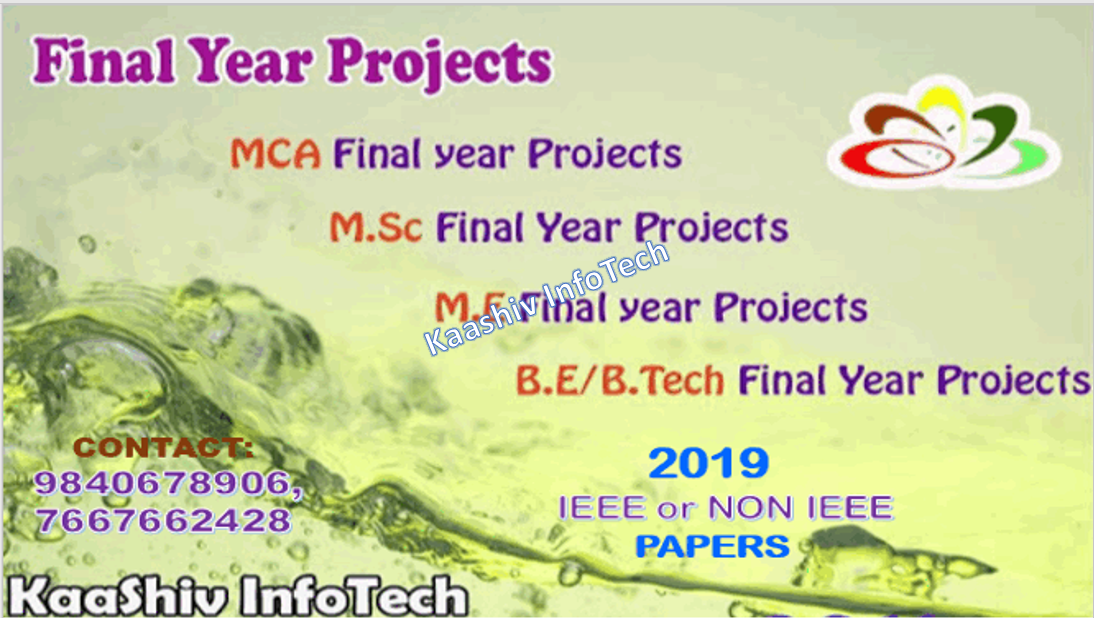
• Real-time project development and Technology Training by Microsoft Awarded Most Valuable Professional
• ieee mini project for ece students involves Full practical training
• Hardware and software tools full support
• Technology training
• Placement training
• Full documentation and report analysis
• R & D projects
• Industrial exposure
• Endorsing Corporate skills
WHAT IS MEANT BY IEEE MINI PROJECT :
• The ieee mini project plays a crucial role in the teaching-learning process.
• It is also a way of identifying the ability of the student to perform an industrial project or applied research linked to the knowledge discipline.
• A project is defined as an effort to create or modify a specific product or service.
• Projects are temporary work efforts with a clear beginning and end.
• project (or program) any undertaking, carried out individually or collaboratively and possibly involving research or design, that is carefully planned (usually by a project team) to achieve a particular aim.
WHAT ARE THE BENEFITS GAINED BY DOING IEEE MINI PROJECT :
• ieee mini project if done well can add a lot of credibility to your profile.
• And especially your ieee mini project building experience can help you perform well in core job placements & higher studies admission interviews.
TIPS TO SELECT GOOD IEEE MINI PROJECTS:
• Analyze the current trends
• Focus your ieee mini project on any social issue
• Get expert’s assistance whenever possible
• Research about the final year projects done by your seniors
• Refer the research journals published by scholars
• Check the feasibility of your final year project
• Work with organizations like Kaashiv InfoTech
WHY, IEEE MINI PROJECT FOR ECE SHOULD BE A REAL TIME IEEE MINI PROJECT :
ieee mini project for ece students provides a real time exposure for the ieee mini project for ece students on the latest and trending technologies. Below are some of the Top jobs in the IT Industry Job Openings ,
• Software Developers – Good in Python, Machine Learning, Data Science and AI programming
• BlockChain Administrators
• IOT Specialists
• Cyber Security
• Web Application Developer – Web Designers
• Information Security Analyst – Security Specialist
• Network Engineers / Analyst
KaaShiv Infotech,for ieee mini project for ece - programme hornes you in the above said skills / job roles from basics to Advanced.
IEEE MINI PROJECT FOR ECE - PROGRAMME HIGHLIGHTS:
• ieee mini project for ece duration: 5days/ 10days / Or Any number of days
• Training hours: 3hrs per day
• Software & others tools installation Guidance
• Hardware support
• ieee mini project for ece Report creation / Project Report creation
• ieee mini project for ece students based 2 projects ( real time)
• Internship Certificate & Inplant Training Certificate & Industrial exposure certificate + (Achievement certificate for best performers)
ADVANTAGES OF OUR- IEEE MINI PROJECT FOR ECE :
• Get Real Work Experience
• Get a Taste of Your Chosen Field
• Start Networking
• Helps You Choose a Speciality
• Helps You Become More Self-Confident
• Boosts Your CV
• Increases Your Market Value
IEEE MINI PROJECT FOR ECE - MATERIALS :
• ieee mini project for ece student , includes Materials after the internship programme
• Technological guidance and materials will be shared in entire year for the students to mold technically.
• Our ece student involves ieee mini project for ece at the end of the programme.
QUERIES OR CONTACT DETAILS :
Venkat (7667662428) and Asha (7667668009)
Email ID: kaashiv.info@gmail.com , priyanka.kaashiv@gmail.com
IEEE MINI PROJECT FOR ECE- Programme Duration :
1 months / 2 months / 3 months to 6 Months ( Any Number of Days - Based on student preferences)
WHO CAN ATTEND THIS IEEE MINI PROJECT FOR ECE PROGRAMME :
ieee mini project for ece - Programme can be attended by the students who are looking for ieee mini project for ece/ ieee mini project for ece 2nd year/ ieee mini project for ece 3rd Year / ieee mini project for ece 4th Year / Internship Jobs / Job seekers
IEEE MINI PROJECT FOR ECE - PROGRAMME OUTCOME :
1. Student will be specialized in Block Chain, Artificial Intelligence, Machine Learning, Python and R programming, Application Development
, Web designing and Networking concepts (Basics to Advanced)
2. Covering 45 concepts
3. Students will be getting trained in / writing 45 Programs – Will change based on the durations of the program.
4. 2 Projects and project documents will be given at the end of the program
REFERENCE YOUTUBE URL FOR IEEE MINI PROJECT FOR ECE:
Check our Internship Training sample videos at this URL –
www.youtube.com/channel
REGISTRATION LINK FOR – IEEE MINI PROJECT FOR ECE:
ieee mini project for ece - Offline - Office training
Fill our online Internship form www.kaashivinfotech.com
IEEE MINI PROJECT FOR ECE – DEMO LINK :
Check out our Sample ieee mini project for ece Content for the training
kaashivinfotech.com/inplant-training-in-chennai-for-cse-demo
CHECK OUR PREVIOUS TESTIMONIALS FROM STUDENTS FROM DIFFERENT COUNTRIES AND DIFFERENT STATES :
www.kaashivinfotech.com/testimonials/
CHECK OUR STUDENTS FEEDBACK ON OUR - IEEE MINI PROJECT FOR ECE:
ieee mini project for ece - Feedback - www.kaashivinfotech.com/inplant-training-feedback /
ieee mini project for ece - Feedback - www.kaashivinfotech.com/internship-feedback
CHECK OUT THE COLLEGES ATTENDED OUR IEEE MINI PROJECT FOR ECE :
www.kaashivinfotech.com/internship-and-inplant-training-attendees/
CHECK OUR SOCIAL SERVICE YOUTUBE CHANNELS :
www.youtube.com/channel
www.youtube.com/channel
REAL TIME PROJECT:
We ranked Top 200 technological companies in Tamil Nadu, www.wikitechy.com
MORE ON OUR, IEEE MINI PROJECT FOR ECE :
In our, internship on ieee mini project for ece - programme below are following different kind of programmes focused such as,
1.ieee mini project for ece(or) paid Final year project for cse,
- Kaashiv Provides an in-depth knowledge of software Platform and other relevant software technologies.
2. ieee mini project for ece work from home – Our company provides facility for the students to learn from home as an Final year project for cse based on latest technological trends.
3. ieee mini project for ece report – Reports are also provided for the final year projects for students in our company related
4. ieee mini project for ece jobs – 100% Job assistance will be provided for the students to gain practical knowledge during the ieee mini project for ece period in our company.
5. ieee mini project for ece summer / Winter internship 2019/2020 – Summer / Winter holiday internship in ieee mini project will be given to the student based on the developer knowledge base.
6. ieee mini project for ece interview questions – We provide top trending and frequently asked question for the intern students during the internship period based on software development and trending technologies.
7. ieee mini project for ece test – Based on the students request, if you are looking for any test to validate your knowledge. we are ready to provide the same.
8. ieee mini project for ece certificate – Industry recognized certificates will be provided for the students who perform internship in our company based .
9. ieee mini project for ece online– Learn ieee mini project for ece from home, our company perform internship through online too.
10. ieee mini project for ece ppt / ieee mini project for ece / projects report – We provide ieee mini project for ece based ppts. projects and project reports as materials after the internship in our company.
11. ieee mini project for ece - Our company will provide free ieee mini project for ece the best students of kaashiv infotech.
12. Project For Diploma ieee mini project for ece – We offer project for the diploma ieee mini project for ece students in our company.
13. ieee mini project for ece 2nd Year / 3rd Year / B-Tech Students – Our company offers you ieee mini project for ece the above students.






